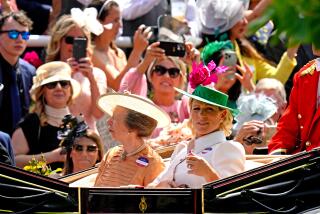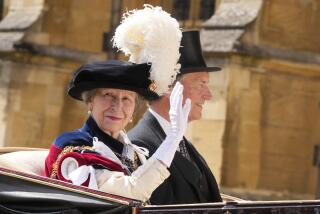From the Archives: Princess Margaret, 71; Sister of the Queen
London — Queen Elizabeth II’s sister, Princess Margaret—whose life was marked by glamour, thwarted love and gilded sadness—has died at age 71, Buckingham Palace announced Saturday morning.
The queen’s sole sibling, four years Elizabeth’s junior, had been frail after a series of strokes and was in a wheelchair for her last public appearances, including Queen Mother Elizabeth’s 101st birthday in August.
The princess suffered another stroke Friday, developed cardiac problems during the night and was rushed from Kensington Palace to the hospital before dawn.
She died “peacefully in her sleep about 6:30 a.m.,” the royal bulletin said. Her children, Lord David Linley, 40, and Lady Sarah Chatto, 37, were with her.
Recalling his “darling aunt,” her nephew, Prince Charles, told reporters: “The last few years with her awful illness were hard for her to deal with, particularly as she was such a wonderfully vibrant woman with such a free spirit.”
The queen, who had been with her ailing mother at Sandringham, the royal residence in Norfolk, returned to Buckingham Palace. The death casts a shadow over Elizabeth’s Golden Jubilee celebrations, which began last week and will culminate in July.
The nation went into mourning as flags flew at half staff from Buckingham Palace, the primary royal residence in London, to city halls in Scotland and Northern Ireland. Crowds of mourners milled outside the palace as well as the Royal Palace of Kensington, where the princess’ body was taken so friends and family could pay respects privately.
Early this week, it is to be moved to St. James’s Palace and will remain there until the funeral Friday.
The funeral, at St. George’s Chapel in Windsor Castle, is expected to be attended only by members of the royal family and friends, while a memorial service will be held at a later date.
Tributes poured in Saturday from the prime minister, other politicians, heads of state, working people and pensioners.
“The whole country will be deeply saddened by Princess Margaret’s death,” Prime Minister Tony Blair said during a trip to Africa. “She will be remembered with a lot of affection.... She gave a great deal of service to the country.”
Her former husband, socialite photographer Lord Snowdon, said he and the children were “extremely saddened.”
A blue-eyed beauty in her youth, Margaret was the Diana of her day. She was gorgeous in a wardrobe judged second only to that of Grace Kelly—he Hollywood actress who became princess of Monaco—and was often in photographers’ lenses.
As the queen’s sister, Margaret had the wealth and privileges of royalty without the responsibility.
She partied at West End theaters and Mayfair clubs, smoked and drank in public when women of her social standing rarely did, and was romantically linked to leading actors and eligible aristocrats of her day.
But, although she had no constitutional role, she soon learned that there were limits on what she could do. Her life became a public tragedy of renounced love.
The Church of England, the British government and the Times of London joined the royal family in opposing her plan to marry a divorced commoner 16 years her senior who had won her heart.
Group Capt. Peter Townsend, a World War II Battle of Britain pilot and equerry to King George VI from 1944 to 1952, was by all accounts the love of Margaret’s life. But under threat of exile and financial ruin, she put duty first and announced that she would not marry him.
Henceforth, she never spoke publicly about him or anything else in her personal life. Like her sister and mother, she did not give interviews.
Townsend, however, reflected on the ill-fated romance in his 1978 autobiography. “I simply hadn’t the weight, I knew it, to counterbalance all she would have lost. It was too much to ask of her, too much for her to give,” he wrote. He died in 1995 at age 80.
Margaret Rose was born to the duke and duchess of York in 1930 at Glamis Castle in Scotland. Six years later, her uncle, King Edward VIII, abdicated to marry divorced American Wallis Simpson, and Margaret’s father assumed the throne as King George VI.
Margaret reportedly said to her sister at the time: “Does that mean you’re going to be queen? Poor you.”
The family moved to Buckingham Palace, where the girls grew up and were educated privately.
As an adult, Margaret insisted that she did not suffer from “second daughteritis” and that, although they had very different personalities, she and her sister rarely argued.
“In our family, we don’t have rifts. We have a jolly good row, and then it’s all over. And I’ve only twice ever had a row with my sister,” she said. She never revealed the source of the two arguments.
During World War II, the family lived in Windsor Castle, 21 miles west of London, to escape continual German bombing, hiding in the dungeons along with the crown jewels. Margaret once described the war years as “black and gloomy” and V-E Day as a “wonderful sunburst of glory.”
After the war, she embarked on the life of a socialite, as well as one of royal duties. After her renunciation of Townsend, she married socialite photographer Anthony Armstrong-Jones in 1960 at Westminster Abbey.
They had two children, and Armstrong-Jones was made Lord Snowdon. The couple led a public life among celebrities and front-page figures of the ‘60s rather than slavishly following royal protocol.
Nonetheless, royal life proved to be a burden for Snowdon, and the pair had a highly publicized divorce in 1978. Britons were sympathetic to a woman whom they viewed as star-crossed in love.
Snowdon married again, while Margaret embarked on a life of parties and affairs with younger men and set up another home on the Caribbean island of Mustique.
She was musical and had a gift for mimicry, but was a chain smoker and heavy drinker and later paid dearly for it. She suffered respiratory illnesses and had part of a lung removed in 1985.
She had a mild stroke in February 1998 and scalded her feet in hot bathwater a year later--an injury that hobbled her for weeks. Another stroke followed last March.
The princess was last seen in public before Christmas at the 100th birthday party of Princess Alice, the dowager duchess of Gloucester.
Sitting in a wheelchair, Margaret wore dark glasses, and her face appeared swollen by medication. She had lost some eyesight and mobility after the strokes.
During her life she was an assiduous patron of the arts, particularly the Royal Ballet and the Scottish Ballet, as well as children’s organizations such as the National Society for the Prevention of Cruelty to Children, the orphanage charity Barnardo’s and the Girl Guides.
Times researcher Janet Stobart in London contributed to this report.
From the Archives: Ex-Chief Justice Rose Bird Dies of Cancer at 63
From the Archives: Doris Lessing dies at 94; British novelist of the ‘female experience’
From the Archives: Cesar Chavez, Founder of the UFW, Dies at 66
From the Archives: Fred Korematsu, 86; Fought WWII Internment of Japanese Americans
From the Archives: Simon Wiesenthal dies at 96; Nazi hunter loyal to the dead
More to Read
Start your day right
Sign up for Essential California for the L.A. Times biggest news, features and recommendations in your inbox six days a week.
You may occasionally receive promotional content from the Los Angeles Times.






